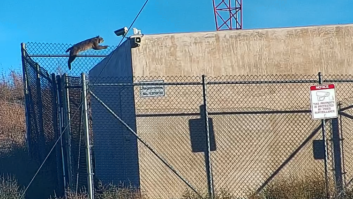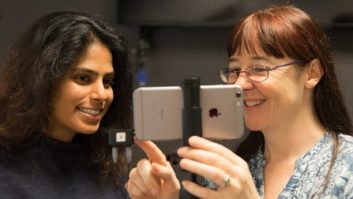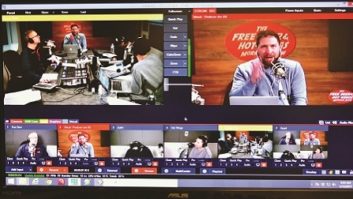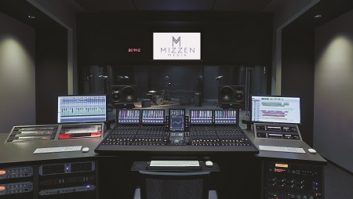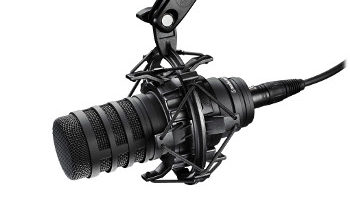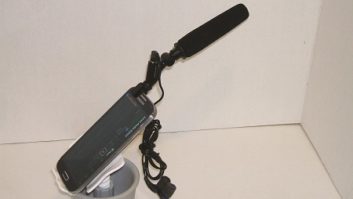Although we’re primarily documentary and corporate video producers, my Video Dads partner and I have worked in public media a long time, so occasionally a public radio station will ask us to help out on a video shoot. Music performance videos are becoming a huge part of radio station content, so we’re always thinking, how do we bridge the audio quality expectations of a radio production with the real-world demands of video production?
Recently, we were hired by KXT(FM), a public radio station in Dallas, to shoot live music performances at SXSW in Austin. This was our second year producing these videos, so we had a better idea of what we were in for, and where we could experiment.
As always, the right gear is an integral part of what enables a shoot to carry out smoothly.

Sennheiser MKE 2 lavalier fits easily inside a Rode Invisilav.
KEEP IT SIMPLE
These performances, even though they are live music, don’t have a dedicated audio person. We are typically three camera operators shooting outside in public places like parks, businesses or even right on the city sidewalks. Keeping it simple and light is a must — but, equally critical is audio quality — which means we go for variety of sources for audio redundancy. And, to add another level of challenge to the productions, we try to keep mics and stands completely out of the shot.
The challenge of shooting musical performances in noisy public places, while keeping mics completely hidden and maintaining a high level of audio acquisition, is a task all on its own. But more importantly, we also want the performer and the audience to feel like the production is not even there. In this case, to guarantee that we come away with a good recording without getting in the way of the performance, redundancy is key, so we record up to five audio sources, even for a solo performer.
We run two channels to our A Camera — a Canon C300 Mark II: a small instrument mic, and a Sennheiser MKE 2 lavalier in a Rode Invisilav housing, gaff-taped to either the guitar strap or underneath the performers clothing to capture vocals. This is the quickest, simplest way to hide a lav while avoiding rubbing noise. We run this lav wirelessly through a Rode RodeLINK Filmmaker kit.

A small space outside our hotel became a remote shoot location. Sound was captured with a lavalier taped to Lolo’s shirt strap and a shotgun picking up guitarist Josh Hoisington.
We run two one or two more audio inputs to our B Camera — a Canon C100 Mark I — such as a specialized microphone like the Rode NTG8 long shotgun, or a small diaphragm hypercardioid condenser mic if we’re shooting indoors.
Both of those camera rigs generally stay on tripods, with comparatively long lenses like a Canon EF 70–200mm, sometimes with a 1.4X extender. We typically record two takes of one song, so the tight shots provide cutaways recorded from different parts of a song. Plus, using long lenses means we can keep those cameras farther from the performer, so that they’re not feeling the pressure of production.
Our C camera, another Canon C100, stays on a small gimbal as an ultrawide, steady shot a few feet from the performer. Here, we’ll run a Rode Stereo VideoMic X on a cold shoe attachment on top of the gimbal handle. Because the SVMX microphone is so close to the performer, while staying behind the camera and out of the frame, it has the potential to give us better audio outdoors than all the others combined.
With an ultrawide angle, it’s always a challenge to get all the gear out of frame. For this reason, we’ve rarely used any short shotgun style mics on these productions — the suggested distances of 2–4 feet from the performers often end up being too short for the microphone’s ideal capture distance. That’s where a long shotgun like the Rode NTG8 helps, as it can be placed further away with more directionality.

The Rode NTG8 shotgun is a handy microphone with a quality sound.
Because we are without a dedicated boom mic operator, we opt to put the NTG8 directly onto a portable light stand. This simple, lightweight setup has worked well for us, and could be made even more flexible by attaching the microphone and shockmount to a simple gooseneck or accessory mount. To our ears, the NTG8 does an amazing job of eliminating off-axis sound, like the omnipresent city traffic we run into at every location.
For our performance with the artist Lolo, we ended up shooting in the backyard of our Airbnb base. I know, I know … that actually sounds like a lame, lazy location move. But, actually it was a pretty great spot, with some cool café lighting, a grove of mesquite trees and even a vintage airstream trailer.
We attached a lav mic under Lolo’s shirt strap, we set up the AKG 414 XLII amplifier mic, and then after a quick sound check we were ready to start rolling. Right when the performance started, Lolo’s guitarist started to sing backup vocals, which we weren’t aware of. So we quickly pointed the Rode NTG8 up toward the guitarist to capture his vocals, and it worked like a charm.
Check out the edited video at https://youtu.be/wMKzS7HL110… and be sure to note: no visible mics for the performers in the shot.

With the small, high-quality cameras that are now available (for purchase or rent), shooting locations are limited only by the imagination. Here, Rayland Baxter is recorded by Slavik Boyechko.
ROUND SOUND
At another location inside a spacious bar, we found ourselves with another challenge.
The performer wanted to use her electric guitar and amp placed right next to her, so we needed to prioritize her vocal capture with as many redundant audio sources as possible.
We hung a hypercardioid condenser a few feet above the performer along a window pane, we kept the Rode SVMX on a gimbal pointed directly at the performer and away from the amp, and we taped a lav mic with the Rode Invisilav under the performer’s shirt collar.
Even though it’s the smallest microphone among a sea of microphones, we have found the lavalier to have the best audio quality in these performances where the singer has to battle loud sound coming from nearby. Best of all, we can hide the lavalier in hair, on a guitar strap, under a shirt, taped to the back of an instrument or a chair, or anywhere that a small lav mic and a Rodelink wireless transmitter can remain out of sight. The omnidirectional nature of our Sennheiser MKE 2 lav mics means we only have to consider distance, rather than direction of the mic, as our main concern.
Overall, I think using a lot of different mics for the audio capture has helped us capture a nice, round sound in these videos for KXT. Sometimes only one source of audio is used, sometimes it’s a mix of both. Often the edit requires a switch between different mics when there are unexpected noises or pops that hit an unmanned microphone. But the lesson is, whenever you only have one or two takes of a song to work with, having several sources of audio is absolutely essential in any video, but it’s especially important when a radio station is producing the video.
The above KXT’s “On the Road” videos were produced and shot by Video Dads and KXT’s Dane Walters, who also edited the videos.
Travis Gilmour is co-owner of Video Dads, an Emmy award-winning production company specializing in video storytelling for documentary, corporate and public media clients. Video Dads also run the site geardads.com, which provide video and audio gear reviews for professional media producers.





